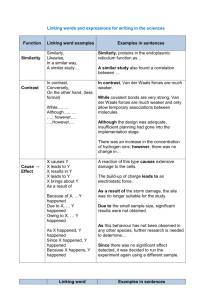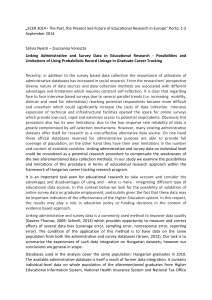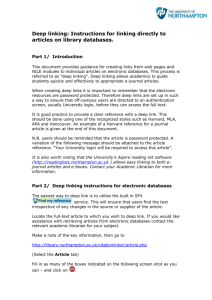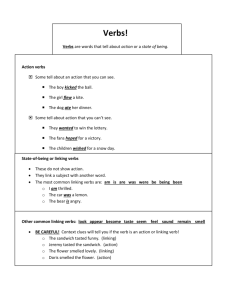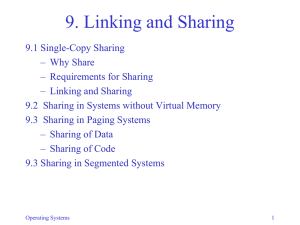translator symbols
advertisement
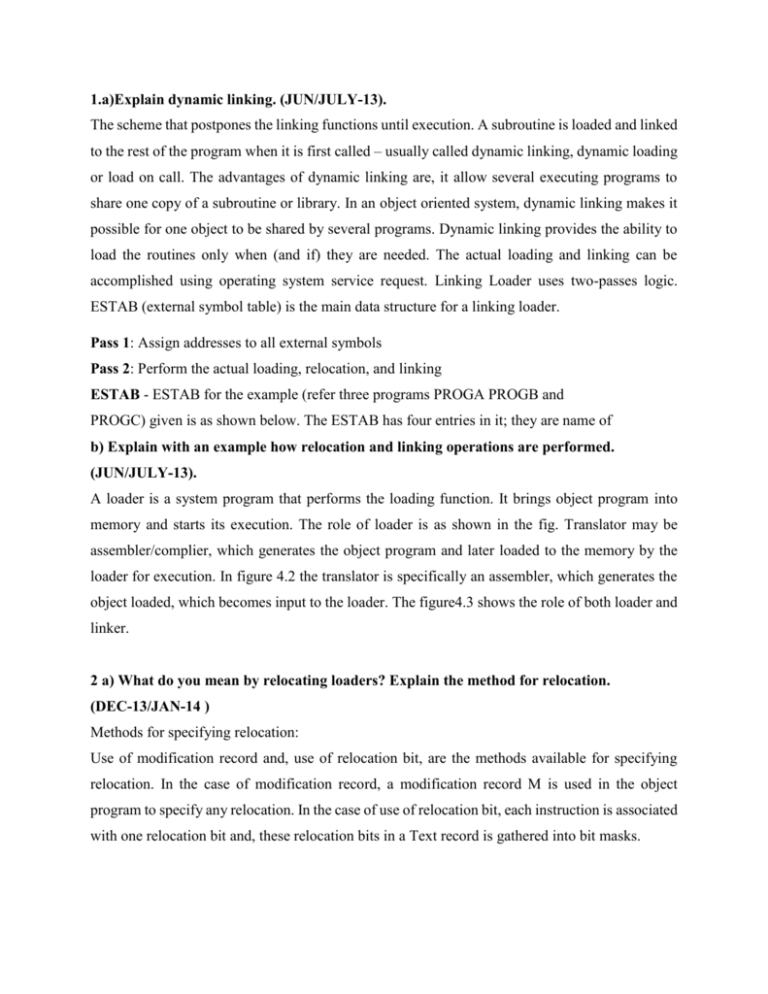
1.a)Explain dynamic linking. (JUN/JULY-13). The scheme that postpones the linking functions until execution. A subroutine is loaded and linked to the rest of the program when it is first called – usually called dynamic linking, dynamic loading or load on call. The advantages of dynamic linking are, it allow several executing programs to share one copy of a subroutine or library. In an object oriented system, dynamic linking makes it possible for one object to be shared by several programs. Dynamic linking provides the ability to load the routines only when (and if) they are needed. The actual loading and linking can be accomplished using operating system service request. Linking Loader uses two-passes logic. ESTAB (external symbol table) is the main data structure for a linking loader. Pass 1: Assign addresses to all external symbols Pass 2: Perform the actual loading, relocation, and linking ESTAB - ESTAB for the example (refer three programs PROGA PROGB and PROGC) given is as shown below. The ESTAB has four entries in it; they are name of b) Explain with an example how relocation and linking operations are performed. (JUN/JULY-13). A loader is a system program that performs the loading function. It brings object program into memory and starts its execution. The role of loader is as shown in the fig. Translator may be assembler/complier, which generates the object program and later loaded to the memory by the loader for execution. In figure 4.2 the translator is specifically an assembler, which generates the object loaded, which becomes input to the loader. The figure4.3 shows the role of both loader and linker. 2 a) What do you mean by relocating loaders? Explain the method for relocation. (DEC-13/JAN-14 ) Methods for specifying relocation: Use of modification record and, use of relocation bit, are the methods available for specifying relocation. In the case of modification record, a modification record M is used in the object program to specify any relocation. In the case of use of relocation bit, each instruction is associated with one relocation bit and, these relocation bits in a Text record is gathered into bit masks. Modification records are used in complex machines and is also called Relocation and Linkage Directory (RLD) specification. The format of the modification record (M) is as follows. The object program with relocation by Modification records is also shown here. Modification record col 1: M col 2-7: relocation address col 8-9: length (halfbyte) col 10: flag (+/-) col 11-17: segment name HΛCOPY Λ000000 001077 TΛ000000 Λ1DΛ17202DΛ69202DΛ48101036Λ…Λ4B105DΛ3F2FECΛ032010 TΛ00001DΛ13Λ0F2016Λ010003Λ0F200DΛ4B10105DΛ3E2003Λ454F46 TΛ001035 Λ1DΛB410ΛB400ΛB440Λ75101000Λ…Λ332008Λ57C003ΛB850 TΛ001053Λ1DΛ3B2FEAΛ134000Λ4F0000ΛF1Λ..Λ53C003ΛDF2008ΛB850 TΛ00070Λ07Λ3B2FEFΛ4F0000Λ05 MΛ000007Λ05+COPY MΛ000014Λ05+COPY MΛ000027Λ05+COPY EΛ000000 The relocation bit method is used for simple machines. Relocation bit is 0: no modification is necessary, and is 1: modification is needed. This is specified in the columns 10-12 of text record (T), the format of text record, along with relocation bits is as follows. b)Explain bootstrap loaders. (DEC-13/JAN-14 ), (JUN/JULY-15). When a computer is first turned on or restarted, a special type of absolute loader, called bootstrap loader is executed. This bootstrap loads the first program to be run by the computer -- usually an operating system. The bootstrap itself begins at address 0. It loads the OS starting address 0x80. No header record or control information, the object code is consecutive bytes of memory. The algorithm for the bootstrap loader is as follows Begin X=0x80 (the address of the next memory location to be loaded Loop A←GETC (and convert it from the ASCII character code to the value of the hexadecimal digit) save the value in the high-order 4 bits of S A←GETC combine the value to form one byte A← (A+S) store the value (in A) to the address in register X X←X+1 End It uses a subroutine GETC, which is GETC A←read one character if A=0x04 then jump to 0x80 if A<48 then GETC A ← A-48 (0x30) if A<10 then return A ← A-7 return 3. a)Write the algorithms of pass1 and pass2 of linking loader. (DEC-13/JAN-14 ) Linking Loader uses two-passes logic. ESTAB (external symbol table) is the main data structure for a linking loader. Pass 1: Assign addresses to all external symbols Pass 2: Perform the actual loading, relocation, and linking ESTAB - ESTAB for the example (refer three programs PROGA PROGB and PROGC) given is as shown below. The ESTAB has four entries in it; they are name of the control section, the symbol appearing in the control section, its address and length of the control section. Program Logic for Pass 1 Pass 1 assign addresses to all external symbols. The variables & Data structures used during pass 1 are, PROGADDR (program load address) from OS, CSADDR (control section address), CSLTH (control section length) and ESTAB. The pass 1 processes the Define Record. Program Logic for Pass 2 Pass 2 of linking loader perform the actual loading, relocation, and linking. It uses modification record and lookup the symbol in ESTAB to obtain its address. Finally it uses end record of a main program to obtain transfer address, which is a starting address needed for the execution of the program. The pass 2 process Text record and Modification record of the object programs. b)Define Linking loader and Dynamic linking. (JUN/JULY-14) The scheme that postpones the linking functions until execution. A subroutine is loaded and linked to the rest of the program when it is first called – usually called dynamic linking, dynamic loading or load on call. The advantages of dynamic linking are, it allow several executing programs to share one copy of a subroutine or library. In an object oriented system, dynamic linking makes it possible for one object to be shared by several programs. Dynamic linking provides the ability to load the routines only when (and if) they are needed. The actual loading and linking can be accomplished using operating system service request. Linking Loader uses two-passes logic. ESTAB (external symbol table) is the main data structure for a linking loader. Pass 1: Assign addresses to all external symbols Pass 2: Perform the actual loading, relocation, and linking ESTAB - ESTAB for the example (refer three programs PROGA PROGB and PROGC) given is as shown below. The ESTAB has four entries in it; they are name of the control section, the symbol appearing in the control section, its address and length of the control section. c)Explain linkage editors. (JUN/JULY-14) The figure below shows the processing of an object program using Linkage editor. A linkage editor produces a linked version of the program – often called a load module or an executable image – which is written to a file or library for later execution. The linked program produced is generally in a form that is suitable for processing by a relocating loader.Some useful functions of Linkage editor are, an absolute object program can be created, if starting address is already known. New versions of the library can be included without changing the source program. Linkage editors can also be used to build packages of subroutines or other control sections that are generally used together. Linkage editors often allow the user to specify that external references are not to be resolved by automatic library search – linking will be done later by linking loader – linkage editor + linking loader – savings in space. 4. a)Explain program linking with an example (JUN/JULY-14). The Goal of program linking is to resolve the problems with external references (EXTREF) and external definitions (EXTDEF) from different control sections. EXTDEF (external definition) - The EXTDEF statement in a control section names symbols, called external symbols, that are defined in this (present) control section and may be used by other sections. ex: EXTDEF BUFFER, BUFFEND, LENGTH EXTDEF LISTA, ENDA EXTREF (external reference) - The EXTREF statement names symbols used in this (present) control section and are defined elsewhere. ex: EXTDEF BUFFER, BUFFEND, LENGTH EXTDEF LISTA, ENDA EXTREF (external reference) - The EXTREF statement names symbols used in this (present) control section and are defined elsewhere. ex: EXTREF RDREC, WRREC EXTREF LISTB, ENDB, LISTC, ENDC The assembler must include information in the object program that will cause the loader to insert proper values where they are required – in the form of Define record (D) and,Refer record(R). Define record The format of the Define record (D) along with examples is as shown here. Col. 1 D Col. 2-7 Name of external symbol defined in this control section Col. 8-13 Relative address within this control section (hexadecimal) Col.14-73 Repeat information in Col. 2-13 for other external symbols b)Explain the algorithm of linking loader? (DEC-14/JAN-15) c) Explain the design options of loader. (DEC-14/JAN-15) There are some common alternatives for organizing the loading functions, including relocation and linking. Linking Loaders – Perform all linking and relocation at load time. The Other Alternatives are Linkage editors, which perform linking prior to load time nd,dynamic linking, in which linking function is performed at execution time Linking Loaders The below diagram shows the processing of an object program using Linking Loader. The source program is first assembled or compiled, producing an object program.A linking loader performs all linking and loading operations, and loads the program into memory for execution. Linkage Editors The figure below shows the processing of an object program using Linkage editor. A linkage editor produces a linked version of the program – often called a load module or an executable image – which is written to a file or library for later execution. The linked program produced is generally in a form that is suitable for processing by a relocating loader.Some useful functions of Linkage editor are, an absolute object program can be created, if starting address is already known. New versions of the library can be included without changing the source program. Linkage editors can also be used to build packages of subroutines or other control sections that are generally used together. Linkage editors often allow the user to specify that external references are not to be resolved by automatic library search – linking will be done later by linking loader – linkage editor + linking loader – savings in space. 5 a)Explain the algorithm of absolute loader? (DEC-14/JAN-15) (JUN/JULY-15). When a computer is first turned on or restarted, a special type of absolute loader, called bootstrap loader is executed. This bootstrap loads the first program to be run by the computer -- usually an operating system. The bootstrap itself begins at address 0. It loads the OS starting address 0x80. No header record or control information, the object code is consecutive bytes of memory. The algorithm for the bootstrap loader is as follows Begin X=0x80 (the address of the next memory location to be loaded Loop A←GETC (and convert it from the ASCII character code to the value of the hexadecimal digit) save the value in the high-order 4 bits of S A←GETC combine the value to form one byte A← (A+S) store the value (in A) to the address in register X X←X+1 End It uses a subroutine GETC, which is GETC A←read one character if A=0x04 then jump to 0x80 if A<48 then GETC A ← A-48 (0x30) if A<10 then return A ← A-7 Return b) Discuss three basic types of computing environments for editors. (DEC-13/JAN-14 ) One important requirement of any IDS is the observation and control of the flow of program execution. Setting break points – execution is suspended, use debugging commands to analyze the progress of the program, résumé
